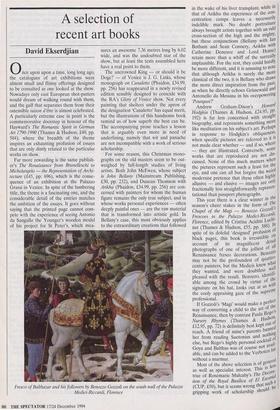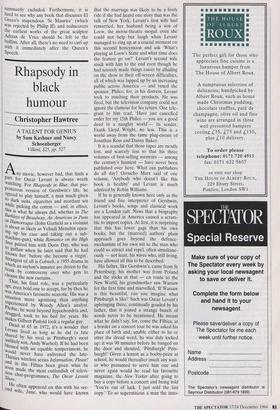A selection of recent art books
David Ekserdjian
Far more rewarding is the same publish- er's The Renaissance from Brunelleschi to Michelangelo — the Representation of Archi- tecture (£45, pp. 696), which is the conse- quence of an exhibition at the Palazzo Grassi in Venice. In spite of the lumbering title, the theme is a fascinating one, and the considerable detail of the entries matches the ambition of the essays. It goes without saying that the printed page cannot com- pete with the experience of seeing Antonio da Sangallo the Younger's wooden model of his project for St Peter's, which mea- sures an awesome 7.36 metres long by 6.02 wide, and was the undoubted star of the show, but at least the texts assembled here have a real point to them.
The uncrowned King — or should it be Doge? — of Venice is J. G. Links, whose monograph on Canaletto (Phaidon, £34.99, pp. 256) has reappeared in a newly revised edition sensibly designed to coincide with the RA's Glory of Venice show. Not every painting that shelters under the apron of the designation `Canaletto' has equal merit, but the illustrations of this handsome book remind us of how superb the best can be. The accompanying prose teaches a lesson that is arguably even more in need of underlining, namely that wit and panache are not incompatible with a work of serious scholarship.
For some reason, this Christmas mono- graphs on the old masters seem to be out- weighed by full-length studies of living artists. Both John McEwen, whose subject is John Bellany (Mainstream Publishing, £30, pp. 232), and Duncan Thomson with Arikha (Phaidon, £34.99, pp. 256) are con- cerned with painters for whom the human figure remains the only true subject, and in whose works personal experiences — often deeply painful ones — are the raw material that is transformed into artistic gold. In Bellany's case, this most obviously applies to the extraordinary creations that followed Fresco of Balthazar and his followers by Benozzo Gozzoli on the south wall of the Palazzo Medici-Riccardi, Florence in the wake of his liver transplant, while in that of Arikha the experience of the con- centration camps leaves a necessarily indelible mark. No doubt portraiture always brought artists together with an odd cross-section of the high and the mighty, but these conjunctions (Bellany with Ian Botham and Sean Connery, Arikha with Catherine Deneuve and Lord Home) retain more than a whiff of the surreally implausible. For the rest, they could hardly be more different, and it is amusing to note that although Arikha is surely the more classical of the two, it is Bellany who draws the more direct inspiration from the past, as when he directly echoes Griinewald and Antonello da Messina in his overpowering Tourquoi?' Andrew Graham-Dixon's Howard Hodgkin (Thames & Hudson, £24.95, PP. 192) is far less concerned with straight biography, and represents something more like meditation on his subject's art. Perhaps in response to Hodgkin's obliqueness, when specific pictures are referred to it is not made clear whether — and if so, where — they are illustrated. Conversely, some works that are reproduced are not dis- cussed. None of this much matters when the pictures represent such a feast for the eye, and one can all but forgive the weird modernist pretence that these often highly allusive — and elusive — images are only fractionally less straightforwardly represen- tational than passport photographs. This year there is a clear winner in the season's cheer stakes in the form of The Chapel of the Magi — Benozzo Gozzolls Frescoes in the Palazzo Medici-Riccardi, Florence, edited by Cristina Acidini Luchi- nat (Thames & Hudson, £55, pp. 388). In spite of its doleful 'designed' profusion 01 black pages, this book is irresistible 00., account of its magnificent detail photographs of one of the jolliest of all Renaissance fresco decorations. Benozz° may not be the profoundest of clattr°: cento painters, but the Medicis knew hat they wanted, and were doubtless we" pleased with the result. Benozzo, identifi- able among the crowd by virtue of the signature on his hat, looks out at us with the cooly appraising gaze of the supreme professional. If Gozzoli's 'Magi' would make a , perfect way of converting a child to the art of tne Renaissance, then by contrast Paula Reg° 5 Nursery Rhymes (Thames & Hudson; £12.95, pp. 72) is definitely best kept out °., reach. A friend of mine's parents banned her from reading Suetonius and nothilig, else, but Rego's highly personal cocktail 0.1.. Goya and Balthus was of course not ava!-I, able, and can be added to the Verboten 11.9 without a murmur. Most of the above selection is of gene"! as well as specialist interest. This is /es' true of Rosemarie Mulcahy's The Decora tion of the Royal Basilica of El Esc°, a (CUP, £50), but it seems wrong that such gripping work of scholarship should be summarily excluded. Furthermore, it is hard to see why any book that discusses El Greco's stupendous 'St Maurice' (which was rejected by Philip II) and rediscovers the earliest works of the great sculptor Adrian de Vries should be left to the boffins. After all, there's no need to curl up With it immediately after the Queen's Speech.











































































































 Previous page
Previous page